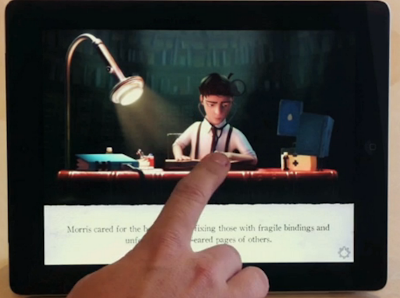All things being equal, the epub format is preferable to pdf for reading on devices like the iPad, Nook, Sony, Kobo, and other dedicated e-readers.
But for some types of books (such as
manga, comics, or graphic novels), epub doesn’t seem to be able to
handle large images that should fill the screen.
Apple has gone so far as to create its own fixed layout format for such ebooks.
It is possible, though, to stick with epub
and get perfect results for illustrated ebooks, using the forgotten (or
perhaps simply overlooked) svg image element.
Here’s a peek under the hood of how we do it at eBookBurn.com, as part of our new illustrated ebook publishing feature.
This is an example of the markup to use in your epub’s xhtml files for each image:
<svg
version="1.1" xmlns="http://www.w3.org/2000/svg"
xmlns:xlink="http://www.w3.org/1999/xlink" width="100%" height="100%"
viewBox="0 0 592 900" preserveAspectRatio="xMidYMid meet">
<image width="592" height="900" xlink:href="images/page01.jpeg" />
</svg>
What this markup does is take a JPEG image
sized 592 pixels wide by 900 pixels tall, and frame it in the center of
a 592×900 svg element.
It turns out that 592×900 is the right size and aspect ratio for “standard-sized” six inch e-ink screens found on the regular Nook, and Sony Reader.
So why use svg at all?
Wouldn’t it be simpler to define it with the plain img tag (as this epub template does), like this?
<img src="images/page01.jpeg" width="592" height="900" alt="Page 1"/>
Unfortunately, many devices, such as the iPad and the Nook Color, have screens larger than six inches.
So on those devices, using the plain img
tag in your epub’s xhtml files leaves an embarrassing whitespace gap,
from where the image stops to where the actual screen ends.
The svg element shown earlier, though, is
different: it stretches the image to fill the entire screen, while
preserving the aspect ratio.
It’s also important to note that 592 width
and 900 height specified within the svg and image elements should not
be thought of as pixel sizes, since no units are defined, but as a
width-to-height ratio.
So any image with the same aspect ratio as
592×900 will work well, regardless of its actual size. Scaling up to
larger screens, though, also means the dpi count should be reasonably
high, at least 72 dpi (and more for images whose base size is smaller
than 592×900 pixels).
For most devices, that’s enough, but some
e-readers insist on adding margins and other padding to each page, so
it’s helpful to define this in the xhtml file’s head block:
<style type="text/css">
@page { margin: 0.000000pt; padding: 0.000000pt; }
</style>
And these css classes in the stylesheet:
.svg_outer {
display: block;
margin-bottom: 0;
margin-left: 0;
margin-right: 0;
margin-top: 0;
padding-bottom: 0;
padding-left: 0;
padding-right: 0;
padding-top: 0;
text-align: left;
}
.svg_inner {
display: block;
text-align: center;
}
So the final xhtml for each page image looks like this:
<div class="svg_outer">
<div class="svg_inner">
<svg
version="1.1" xmlns="http://www.w3.org/2000/svg"
xmlns:xlink="http://www.w3.org/1999/xlink" width="100%" height="100%"
viewBox="0 0 592 900" preserveAspectRatio="xMidYMid meet">
<image width="592" height="900" xlink:href="images/page01.jpeg" />
</svg>
</div>
</div>
Just repeat that pattern for every image in book, for every chapter that contains full-page illustrations.








































